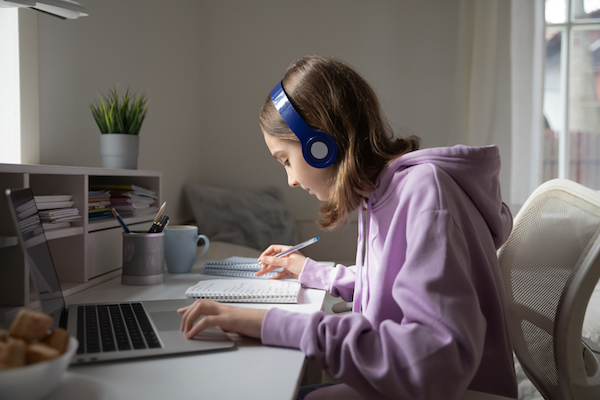With so many kids learning from home during this unprecedented start to the new school year, students are in need of help concentrating, staying focused and remaining in good spirits. Music might be just what the doctor ordered, according to the parenting experts at online learning and homework help community Brainly.
Soothing, relaxing music can help students minimize stress or anxiety while learning virtually. During long study sessions, music can also aid endurance. And in some cases, music can help kids with memorization.
The five main benefits of listening to music while learning from home include:
- Helps with concentration. Listening to music can help students block out surrounding noise that may distract them. By doing so, it can help them to focus better, improving their concentration.
- Stimulates the brain. The tunes and rhythms of music can help to stimulate the brain, and research has even found that certain music can even enhance creativity.
- Improves motivation. It can be hard to stay motivated during virtual learning, and at its core, music has the ability to alter one’s mood. Listening to a specific type of music can make one’s mood more positive, which in turn can improve motivation.
- Lowers stress. Music’s mood-altering ability can help to lower stress. Not all types of music will help to lower stress, though, so that’s why it’s important to find the right type of music.
- Eliminates boredom. When students are doing schoolwork alone at home, it can seem like nothing new or interesting is happening, and things can start to feel stale. Listening to music can make it easier to stay interested and energized.
When it comes to the type of music that works best, Brainly’s parenting expert Patrick Quinn said, “Everyone is different, and every situation is different. Watch your child, see how they respond and experiment. If a piece of music doesn’t evoke the right mood, try something else.”
Keep in mind that some kids may find music distracting. “Ask them how loud or soft they want the music—or if they want it at all,” Quinn added.
So what types of music are best for improving cognitive ability and mood? It depends on the student, but here are the five best music genres for learning from home:
- Classical Music. When trying to tune out distractions like the leaf blower next door or people in the household using a loud “Zoom Voice” in virtual meetings, classical music may be exactly what students need in order to focus when learning from home.
- Ambient/Chill. When the home environment is bustling, students’ brains will try to process all the sound as data. In that case, it’s may be the time to slip on headphones and some mellow, ambient feel-good music.
- Nature Sounds. Effective studying requires a relaxing, stress-free environment. What better way to create this than to listen to calming nature sounds while hitting the books? From gentle rainfall to jungle canopies, the natural world has no shortage of soundscapes to get lost in.
- Modern Electronic. This type of music is known to trigger neurotransmitters like serotonin and norepinephrine, resulting in faster results with fewer errors. It’s particularly helpful for labor-intensive research projects or tasks that require memorization.
- Video Game Music. Listening to video game music can help students focus and stay motivated. The excitement that often accompanies playing video games is an effect of the music crafted for them, and it can also provide the same effect for students doing tedious or monotonous assignments.
Listening to music while studying has many benefits. However, its benefits might vary based on the type of music and individual.
Volume can be just as important of a factor as the genre, too. Kids should listen to music at a moderate volume because the louder it is, the more likely it is to distract them.
Encourage kids to pre-make playlists for the school day ahead of time and let them play all the way through. The whole point of listening to music while learning from home is to get in the zone and limit distractions, and nothing is more distracting than having to change the song every few minutes.
The ideal playlist should last for 40 to 50 minutes. When the playlist ends, this will act as a reminder to take a short break from learning or switch to a new subject or task.
For more from the Music & Sound Retailer, click here.


